Vol 2 No. 8 TROPIC LIGHTNING NEWS February 27, 1967
Index
25th Destroys Another VC Base Camp
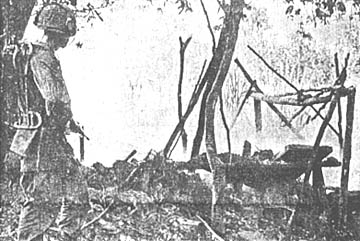 |
BURNED OUT - A radio operator of Co. A, 2nd Bn,, 1st Inf., watches the wreckage of a Viet Cong hut smoldering during Operation "Gadsden." The hut was part of a Viet Cong Base Camp found in War Zone C. (Photo by Sp4 Robert Brown) |
Mechanized Unit Kills 6 Viet Cong in Fight
Elements of the 25th Inf. Div. were credited with killing six Viet
Cong and destroying an enemy base camp last week during Operation 'Gadsden'
in Tay Ninh Province.
The enemy base camp was found about 20 miles northwest of Tay Ninh
City in the dense jungles of War Zone C, near the Cambodian border.
A "Tropic Lightning" mechanized infantry unit, attached to the
196th Lt. Inf. Bde., destroyed 10 Viet Cong structures and captured two
individual weapons, 500 rounds of small arms ammunition and 20 pounds of
documents. Friendly casualties were reported as light.
Participating in Operation Gadsden are units of the 25th Inf. Div.,
196th Lt. Inf. Bde., and the 3rd Bde., 4th Inf. Div. Three Viet Cong were
killed during sporadic fire fights 15 miles northwest of Tay Ninh City.
Two more were killed by artillery fire in Binh Duong province 7 miles northwest
of Saigon.
A mechanized unit attached to the 196th Lt. Inf. Bde. discovered a
fresh grave with the body of one VC while on patrol through the dense jungle
surrounding Tay Ninh City. The enemy was killed by the infantrymen in a
firefight several days before.
The grave was located in a thick woodline near the opening of a
trail that the mechanized unit had stopped to investigate earlier in the day.
Another mechanized infantry unit attached to the 3rd Bde., 4th Inf.
Div., at Dau Tieng killed two more Viet Cong when a recon element spotted five enemy
soldiers hiding in the dense undergrowth near a natural clearing. The
mechanized units had halted for the night in the clearing, and the VC were
attempting to infiltrate their position at 9:30 p.m. when they were spotted and
routed with .50 caliber machinegun fire. The other three fled into
the darkness.
An additional 11 Viet Cong killed by the 25th Inf. Div. were
reported at the week's end. Overall friendly casualties for the entire
week were considered very light.
New 196th Recon Patrol Scores
The six men in camouflaged fatigues and floppy hats stared
excitedly as artillery rounds crashed into the jungle before them. Just
minutes before they had been in that same jungle. Now they were out safe,
and they wondered how Charlie was faring amidst the artillery-torn trees and
brush.
It had been a successful night ambush for the 196th Lt. Inf.
Bde.'s newly formed Long Range Reconnaissance Patrol. Their
uncontrollable pride belied their modesty later, as they told of how they
notched the patrol's first VC kill.
"We were about 50 yards from the woodline when I called a
security halt." said Sgt. Anthony Mazzucchi of Blackwater. N.Y., the patrol
leader. "I sent SP4 Richard Bologna of Buffalo, N.Y., back to check on
our rear element."
Specialist Bologna talked with PFC Caro Velleri of Buffalo. N.Y.,
the assistant patrol leader, who was rear guard security. PFC Velleri said
he heard movement to his rear. Sgt. Mazzucchi called the information back
to headquarters, then got orders to move on.
At the woodline, Sgt. Mazzuchi left PFC Velleri and another man at
its edge while he and the others searched for an opening which would allow them
into the thick brush. The sound of movement PFC Vefleri had heard still
trailed them.
Once inside the woodline, the patrol set up a hasty ambush and
waited for their pursuers. Minutes passed and soon there was movement, but
not from the direction they had anticipated.
Coming up along another path were three VC. The patrol
waited, then opened up with their M-16's, Sgt. Mazzucchi and Specialist
Bologna both tossing hand grenades at the surprised Cong. One VC was
killed instantly.
Other groans could be heard as the patrol got up and moved back out
to the clearing. A quick check by Sgt. Mazzucchi revealed that none of his
men had been hit. Safe in the small defensive perimeter in the clearing,
the patrol leader called in artillery on the VC.
VC Hospital Housed Top Facilities
"Outside of the extremely unsanitary condition they operate in,
their medical facilities are surprisingly good," observed PFC James L. Brown,
a member of the 1st Bn., 35th Inf., Reconnaissance Platoon, as they uncovered a
VC underground hospital facility.
PFC Brown, a line medic, took professional interest in the hospital
section of the cave complex his platoon was securing and exploring.
Among the items PFC Brown discovered in the natural caves were
U.S.-manufactured penicillin syringes full of anti-tetanus serum from the Soviet
Union and numerous medical pamphlets and instruction books in Vietnamese.
"We also found a stone slab that was evidently used as an
operating table," said PFC Brown, "but the surgical instruments were
gone."
1/5th Repels VC Battalion In Action During 'Gadsden'
Units of the 1st Bn. (Mech.), 5th Inf., traded blows with an
estimated Viet Cong battalion for more than a half hour recently during Operation
"Gadsden."
The enemy attacked with recoilless rifles, automatic weapons and
small arms fire. The recon element quickly returned the fire, holding off
the VC force.
Battalion commander, Lt. Col. Richard C. Rogers, brought Co. C in
to give additional fire support. Facing the overwhelming fire power, the
Viet Cong broke contact and fled into the surrounding jungle.
The Bobcats then destroyed numerous bunkers, buildings and tunnels,
denying them the use of these fortifications in further actions against our
forces.
The "Tropic Lightning" infantrymen were attached to the 196th
Lt. Inf. Bde., operating approximately 19 km northwest of the city of Tay Ninh.
The task of the "Bobcats" was to curb VC activity, and to deny the enemy of
yet another area of operation.
| DESTRUCTION - A mountain of logs remains after 25th division troops sweep through Tay Ninh Province on Operation "Gadsden". | 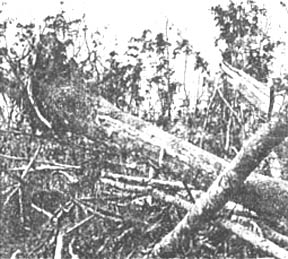 |
Page 2 TROPIC LIGHTNING NEWS February 27, 1967
Decorated
| SILVER STAR | |
| PFC Dale W. Flickinger, CO. C, 3rd Bn., 21st Inf. | |
|
BRONZE STAR MEDAL (VALOR) |
|
|
Capt. James Thompson, HHC, 196th Lt. Inf. Bde. 2nd Lt. James G. Mikesell, Co. C, 3rd Bn., 21st Inf. PSgt. Leslie T. Miles, Co. C, 3rd Bn., 21st Inf. PSgt. Robert F. Stairwalt, Co. D, 4th Bn.. 31st Inf Sgt Monroe C. Griffin, Co. C, 2nd Bn., 1st Inf.. Sp4 Victor J. Bey, Co. B. 2nd Bn., 1st Inf. Sp4 William K. Commins, Co. B, 2nd Bn., 1st. Inf. |
Sp4 Gary Scothon, Co. C, 3rd Bn., 21st Inf. Sp4 Napoleon Tabora, Co. A, 2nd Bn., lst Inf. Sp4 Barry W. Wood, Co C, 2nd 13n., 1st Inf. PFC David L. Csrlson, HHC, 2nd Bn., 1st. Inf. PFC Ronald C. Douglas, Co. C, 3rd Bn., 21st Inf. PFC Robert T. Turner. Co. A, 2nd Bn., 1st Inf. |
|
ARMY COMMENDATION MEDAL (VALOR) |
|
|
Sp4 Johnny B. Brownstead, Co. C, 3rd Rn., 21st Inf. Sp4 John B. Fezi, Co. C, 3rd Bn., 21st Inf. |
PFC Harry A. Mullaney, Co. C, 3rd Bn., 21st Inf. |
|
PURPLE HEART |
|
|
1st. Lt. Ronald B. Mattioli. Trp. F, 17th Cav. PSgt. Edward C. Hensley, HHC, 196th Lt. Inf. Bde. SSgt. Larry B. Acton. Co. B, 4th Bn., 31st Inf. SSgt. Robert. D. Balser, Co. B, 2nd Bn., lst Inf. SSgt. David D. Cornileus. Co. A, 2nd Bn., 1st Inf. SSgt. Roosevelt Cook. 175th Engr. Co. SSgt. Garland P. Felton, Co. B. 2nd Bn., lst Inf. |
SSgt. Leopold O. Griffith, Co. B, 4th Bn., 31st Inf. SSgt.. Stoeberl Hehmut, Co. R, 4th Bn., 31st. Inf. SSgt. Adron L. Jennings, Co B, 2nd Bn., 1st Inf. SSgt. George M. Lyons, Co. B, 3rd Bn., 21st Inf. SSgt. Joseph W. McCulloch, Trp. F, 17th Cav. SSgt. Ralph E. Roach, Co. B, 2nd Bn., 1st Inf. SSgt. Lester Armstrong, Co C, 3rd Bn., 21st Inf. |
Buddha, Ancestors And National Heroes
Venerated in Hoa Hao
Religious Ritual
(Editor's Note: This is the seventh and and last in a series of
articles describing the major religions of Vietnam and their relative influence
upon its people and their history.
The Hoa Hao sect, essentially a variant of Hinayana Buddhism, was
founded in 1939 by Huynh Phu So. So impressed were the people with his
sincerity and zeal, that stories began to spread about the miraculous cures he
performed with simple herbs and acupuncture - a Chinese medical technique for
curing illness, by which the skin is pierced with needles.
Huynh Phu So set forth his religious ideas - first preached in
village street corners and canal intersections - in his book Sam Gian (Oracles
and Prayers). His basic theme stressed the importance of internal faith
and the unimportance of external experience. "It is better," he wrote,
"to pray with a pure heart before the family altar than to perform elaborate
ceremonies in a pagoda, clad in the robes of an unworthy priest."
Huynh Phu So approved of prayers and offering only to Buddha, the
ancestors and the national heroes. Every member of the sect was expected
to pray four times a day. Although the ancestors were venerated, Huynh Phu
So particularly disapproved of elaborate and expensive funerals.
In the chaos following the Japanese surrender, Huynh Phu So led his
followers into politics, forming the Vietnam Social Democratic Party (usually
called Dan Xa). In April 1947 he was ambushed and killed by the Viet Minh
and his remains were scattered. No leader of equal stature emerged in the
sect after Huynh Phu So's death. Consequently the extensive area
southwest of Saigon, where the Hoa Hao were concentrated, broke up into a number
of so-called Hoa Hao "baronies" ruled like feudal states.
In the spring of 1955, the central government in Saigon asserted
its control over the entire area, using military force. Several of the Hoa
Hao leaders were outlawed and the most powerful of them, Ba Cut, was arrested in
April 1956, tried, and executed in July.
More Than 47,000 Returnees Reflect
Effectiveness of Chieu Hoi Program
The Chieu Hoi program was a notable success in 1966, a year of many
successes in the war against the Viet Cong. More than 20,000 VC and
sympathizers voluntarily returned to the Government of Vietnam during the year.
That is nearly twice the number that came in during 1965.
The total number of VC to join the Vietnamese government since the
Chieu Hoi program began in 1963 has risen to more than 47,000.
Some of the most significant results of the program are not
reflected in statistics. For instance, Chieu Hoi officials consider the
surrender of North Vietnamese Lt. Col. Le Xuan Chuyen the outstanding single
result of the 1966 program.
Col. Chuyen, a veteran of 20 years' service to the communists,
had taken part in 50 major battles, received 35 citations and was deputy chief
of staff of the VC 5th Div. when he voluntarily came over to the government of
Vietnam.
"The intelligence value alone has already saved many lives,"
one official said of Col. Chuyen's return.
Some of the largest returnee movements result directly from
military operations. During the coordinated Operations Irving, Maeng Ho 6,
and Dal Bang 800 in Binh Dinh Province last fall, about 160 VC rallied to the
government.
Operations in nearby Phu Yen Province soon afterward brought in
another 500. This January's Operation Cedar Falls in the Iron Triangle
also brought a large number of returnees (figures are not yet complete).
Officials point to 14 VC attacks on Chieu Hoi centers during 1966
as evidence of VC opposition to the program and their fear of its effect on
their cause.
Carefully kept promises of good treatment are the key to Chieu Hoi
success. This good treatment, extended to a detainee paid off for the U.S.
1st Inf. Div.
A seriously wounded VC officer was detained by the division.
He expected to be killed, but the way he was treated convinced him that his VC
leaders had lied.
Now a Chieu Hoi returnee, he works for the "Big Red One" as a
psychological operations advisor, telling his former VC comrades that we tell
the truth and keep our promises.
Report Shows Impressive 1966 Civic Action Totals
Civic action programs conducted by U.S., Free World and Republic of
Vietnam Armed Forces in support of Revolutionary Development during 1966 showed
impressive results for the year. These examples are from the many which
could be cited.
These forces constructed 2,013 new homes for the people of Vietnam
and repaired 3,887, to provide housing for 8,918 families during the year.
Free World Forces, including American and Vietnamese, recovered
12,597,871 pounds of rice, 79,780 pounds of salt and 465 head of cattle from the
Viet Cong for distribution to the South Vietnamese People.
Other commodities distributed during fire year included 17,104,000
pounds of food, 1,516,000 pounds of clothing and 578,000 pounds of soap.
There were more than 10,000 English classes held in 1966 by Free
World and Vietnamese forces. These classes were attended by some 261,000
Vietnamese. Also conducted were 525 vocational training classes for
selected trades.
Other construction and rebuilding projects completed in 1966 by
Free World and Vietnamese forces included 500 bridges, 191 places of worship,
245 dispensaries, 81 hospitals, 85 orphanages, 447 schools, 1108 classrooms and
other smaller projects.
The total number of immutnzations administered by the combined
medical forces was 1,139,138.
Through the Medical Civic Action Program (MEDCAP) there were almost
seven million patients treated during the 11 months of the year for which
figures are available. The Free World medics handled 5,338,101 of these
and the Vietnamese personnel treated another 1,529,650.
American, Free World and Vietnamese Servicemen, through voluntary
contributions, donated a total of $341,040 in 1966 toward such worthy causes as
orphanages, schools, hospitals and general welfare.
Editorial
A Marked Man
Try asking various people what diplomacy means to them and they
respond with different definitions.
To a member of the diplomatic corps, it means furthering the
national goals and objectives of our country. To the businessman, the art
of diplomacy may have an economic basis; to the tourist it means an opportunity
to learn, study, and understand.
And to the soldier overseas keep in mind that they represent the
American way of life and act accordingly. They also appreciate the fact
that people of other countries are different from Americans.
Thus, our soldiers concern themselves with the rules and
regulations that the local population abides by. The soldier's
willingness to establish contact with a nation's people creates a favorable
impression and promotes good will for our country - the art of diplomacy.
The application of this principle is just as important to the
soldier stationed at some port in the United States. He may come from a
Western state, but find himself on duty in the East where regional customs and
traditions may vary somewhat from those he has grown up with.
Once again, thoughtfulness and understanding must be exercised.
Courtesy and respect have no boundaries.
Whether at home or overseas, the American soldier is, after all, a
marked man. It is the local populace that watches him, judges him, and
through him the Army and the United States.
The TROPIC LIGHTNING NEWS is an authorized publication of the 25th Infantry Division. It is published weekly for all division units in the Republic of Vietnam by the Information Office, 25th Infantry Division, APO San Francisco 96225. Army News Features, Army Photo Features, Armed Forces Press Service and Armed Forces News Bureau material are used. Views and opinions expressed are not necessarily those of the Department of the Army. Printed in Tokyo, Japan, by Pacific Stars and Stripes.
Maj. Gen. Fred C. Weyand . . . . . . . Commanding General
Lt. Col. J. L. Aiken . . . . . . . . . . . . . . Information Officer
Capt. John P. Fortner . . . . . . . . . . . . Officer-in-Charge
Sp4 David L. Kleinberg . . . . . . . . . . Editor
Sp4 Adrian E. Wecer . . . . . . . . . . . . Editorial Assistant
Sp4 John R. Dittmann. . . . . . . . . . . . Editorial Assistant
Page 3 TROPIC LIGHTNING NEWS February 27, 1967
Sergeant 'Polices Up' Second Silver Star
Sgt. Larry J. Hollaway of Coquille, Ore., a member of the 1st Bn.,
14th Inf., "Golden Dragons," won his second Silver Star within nine months
during Operation "Thayer II."
The 3rd Bde. Infantryman won the award for the part he played in
what was perhaps the biggest find of the operation, a massive underground Viet
Cong complex.
The 25th division infantryman received the star for what he
modestly called "policing up the area." Policing up the area involved
clearing a dark, unfamiliar cave and killing six North Vietnamese regulars with
a 45-caliber pistol.
Brig, Gen. William A. Becker, the assistant division commander for
the 1st Air Cav. Div., presented Sgt. Hollaway his second Silver Star at the
cavern site and remarked, "This is the appropriate place to receive this
award, on the field of battle."
Sgt. Hollaway's first silver Star was awarded for pulling a
wounded man back into the perimeter while he himself was wounded. That
action occurred last November 13 at the "Battle for Dragon Crater" where the
1st Bn., 14th Inf., "Golden Dragons" encountered three NVA companies.
Sgt. Hollaway earned his second star while searching a hillside
near a known enemy filtration route called the "Oregon Trail" on January 25,
1967.
He and his men found a large cavern which they proceeded to clear.
They killed nine NVA in the process and discovered an extensive hospital
complex, probably the most important find of Operation Thayer II to date.
Sgt. Hollaway killed six while armed with only a .45 caliber pistol. They
found large quantities of weapons, medical dressings, surgical gowns, plasma and
packs - indications that the hospital supported at least a regimental size enemy
force.
The 21-year-old sergeant described the rock complex as "an ideal
set-up far a field hospital with hammocks hanging from the walls, a moderate
temperature and an underground water supply."
After all the supplies were evacuated, Co. D, 65th Engrs, deprived
the NVA of any future use of the cave by caving in the complex with an
explosive.
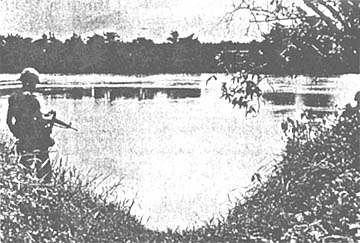 |
PEACEFUL - A weary "Tropic Lightning" infantryman pauses at the river's edge to contemplate the serene beauty of its waters and enjoy one of those rare moments of peace in war. (Photo by PFC Vernon Shibbla) |
Ambush Nets Wounded VC Officer
The 12 Viet Cong had traveled 15 nights and had hid days carrying
their wounded officer trying to find a hospital. Every tunnel they visited
had either been demolished or rained out.
While on night patrol a platoon of Co. B, 2nd Bn., 27th Inf.,
"Wolfhounds," sprang an ambush on them. At the first burst of gunfire
the stretcher bearers dropped their officer and vanished.
Upon checking the results of the ambush the Wolfhound soldiers
found nine VC dead. The wounded officer was captured.
The officer, angry at being deserted by his men, reported that 20
more VC were following. The infantrymen set up an ambush again but no more
VC appeared.
All things considered, the Wolfhounds made a capital gain from some
very frightened stretcher bearers who thought discretion really is the better
part of valor.
Tropic Lightning Strikes VC Twice
Even though they say that lightning never strikes twice in the same
place, the men of Co. B, 4th Bn. (Mech), 23rd Inf., recently proved that al
least one form of lightning - "Tropic Lightning" - does.
For the second clay in a row during Operation "Gadsden" Co. B
moved into a well hidden, but deserted Viet Cong base camp in War Zone "C"
near Tay Ninh. The Tropic Lightning infantrymen were forced to leave the
camp the first day in order to get their armored personnel carriers (APCs)
positioned in a safe place prior to darkness.
Early the second day the company's APCs moved back to the
deserted VC base camp to continue their search of the area. After
positioning the tracks in a defensive perimeter around the base camp, the men
dismounted and began searching the camp.
"We got off the tracks and began poking our noses into every
banker and trench we came to," said Sp4 Woodrow E. Calvert Jr., 20, of
Charleston, W. Va. As the day progressed, reports of finds of clothing and
small quantities of rice began floating into the company command post.
Exasperated because he hadn't personally found anything, Sp4
Calvert made his way into the last bunker. Climbing tiredly into the
well-built fortification, he began probing the dirt floor for any hidden
treasures.
"I was really taken by surprise when the point of my machete
struck against something metal. At first I thought I had found some mortar
rounds or something like that," said Sp4 Calvert.
Instead, what the specialists found was 175 cans of sardines.
In addition to the sardines, several other miscellaneous items were
discovered and evacuated from the ill-fated base camp.
After the captured items were all moved from the vicinity, the
company moved from the area and the base camp was destroyed.
Tropic Lightning may not be the same as regular lightning, but as
far as Viet Cong base camps arc concerned, the results can be much the same.
Sup. Com. Keeps 'Gadsden' Rolling
Operation "Gadsden," now taking place in the lush, Viet Cong
infested jungles of War Zone "C," demands maximum support to keep the
"Tropic Lightning" infantrymen constantly on the offensive.
To cope with this large problem, the division's Sup. Com. has
taken every possible step to keep the supplies moving to the units in the field.
At the division's forward command post in Tay Ninh, Sup. Com.
headquarters has set up a logistical operations center (LOC) to expedite supply
missions. Representatives of each Sup. Com. unit are stationed in the LOC
coordinating requests for supplies and maintenance and directly controlling the
issue of all supplies.
In addition to the LOC, several of the units have representatives
or work parties with the units to keep maintenance problems at a minimum.
The 725th Maint. Bn., for example, has a repair crew with the division's two
mechanized units to help keep the armored personnel carriers battle ready.
They also have a track vehicle advisor with the 196th Lt. Inf. Bde.'s 8th Sup.
Bn. In addition, members of the battalion's artillery repair shop are
stationed with the field artillery units.
The 25th Supply and Transportation (S&T) Battalion holds the
job of keeping truck conveys steadily on the move from supply points to the
field units. On an average day, the S&T Bn. hauls 165 tons of
ammunition alone.
Finally, the 25th Med. Bn., has a liaison man working close by the
196th's medical units in Tay Ninh.
The 25th Division's combination of fine infantrymen and support
ability has paid off in the first phases of Gadsden as the division tallied up
117 VC dead, 286 tons of rice captured and several bases taken.
APC Hangs on Edge of Pit;
Outcome Is in The Balance
Men of the 2nd Plt., Co. B, 4th Bn. (Mech.), 23rd Inf., recently
learned the art of balancing an armored personnel carrier (APC) the hard way.
The action occurred during operation "Gadsden" conducted in the
jungles of War Zone C, 65 miles northwest of Saigon.
Crashing through the heavy undergrowth, one of the platoon's APCs,
or "tracks," came upon an anti-tank pit. Too late to change
directions, the driver, PFC Roger Evans, 20, of Chico, Calif., braked the vehicle, balancing it on the edge of the
pit. The quick reaction kept the vehicle from plunging into the pit and
avoided damage and injury.
Suddenly the front of the APC began to rise sharply in the air and
just as suddenly dropped. PFC Evans immediately applied the brakes.
The momentum of the track threw everyone forward and PFC Anthony Blanchard fell
over the front and into chest-deep water.
"Don't breathe," said SSgt. Rufus J. Elliott, platoon
sergeant for the 2nd Plt., and the situation was just that critical.
The APC was almost vertical, nose down and still eight feet from
the bottom of the pit. The slightest movement could send it plunging to
the bottom.
Sgt. Elliott immediately grabbed the radio microphone and called
for help. Soon a track appeared and pulled them to safety.
18 Jungle Bases Denied Viet Cong
In the first six days of Operation "Gadsden," two brigade-sized
infantry elements under the direction of the 25th division uncovered 16 enemy
base camps and two enemy supply bases.
The camps, ranging from company to battalion size, were found along
the Rach Beng Go River. They have yielded 10 small arms, 254.85 tons of
rice, 231 structures and 336 fortifications since the operation began on
February 2.
After breaking through foxholes and trenchlines fortifying the
camps, the three mechanized infantry and three standard infantry elements
involved in Gadsden found assorted billets, mess halls, classrooms, storerooms
and dispensaries.
After evacuating the contents, infantrymen destroyed each of the
camps.
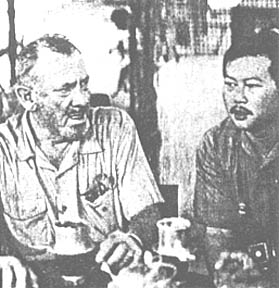 |
WRITER - John Steinbeck chats with Vietnamese correspondents in the village of Rach Kien, presently undergoing an extensive pacification initiative of the 2nd Bn., 14th Inf. Steinbeck traveled the country to gain first-hand knowledge of the war. |
Page 4-5 TROPIC LIGHTNING NEWS February 27, 1967
Photos by PFC Vern Shibla
PFC Vern Shibla is a photographer for the 25th Division
Information Office. The 23-year-old native of Fullerton, Calif., become
interested in photography five years ago. He has been at it ever since.
The photographs shown here were taken on division operations during the last year.
They present a graphic example of the hopes and fears, the joy and
the sorrow that typify the war in Vietnam. PFC Shibla has a knack for
catching a child's face at its most eloquent or the action of battle at its
peak. He will go anywhere the action is if it will help tell the story.
Each of the pictures on these pages is a chapter in that conflict.
| Fear | 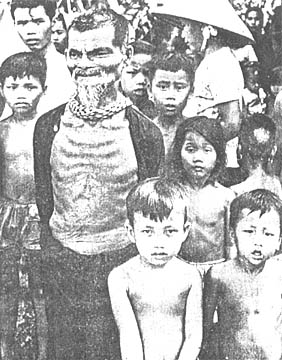 |
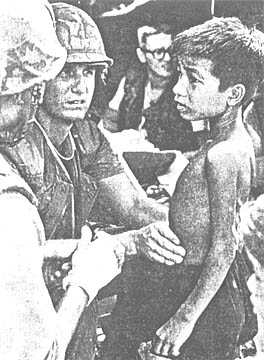 |
Hope |
| Joy | 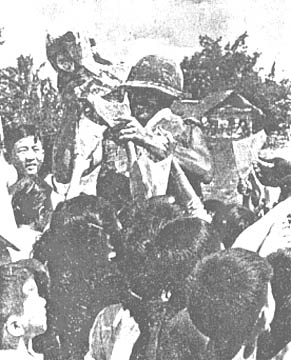 |
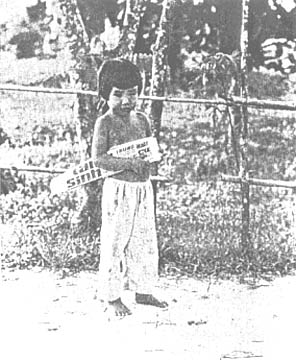 |
Sorrow |
| Trapped | 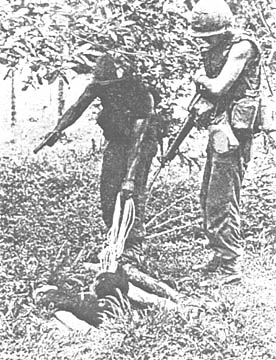 |
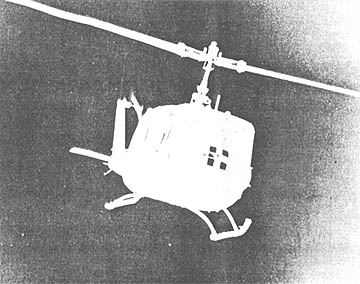 |
Dustoff |
| Assault | 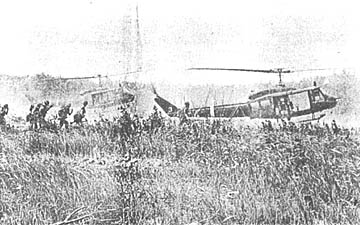 |
Page 6 TROPIC LIGHTNING NEWS February 27, 1967
Division Airfield Completed by 65th Engrs.
| A VC-2B "Caribou" comes in for a landing at the division's new airfield | 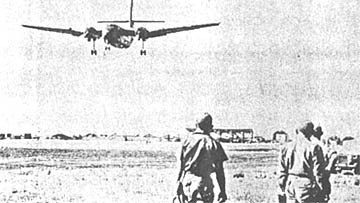 |
Thirty-eight men battled time, the elements and Viet Cong snipers
to build a 2800 foot airfield at the division's Cu Chi base camp in just a
month and a half.
Officially designated a medium lift, forward area, division base
airfield, the strip was just one impossible difficulty after another - but the
65th Engrs. came through in fine style.
Foreman for the job, PSgt. Victor K. Bloomfield, 32, of Clarinda.
Iowa, proudly told of the way his men overcame the numerous problems they
encountered. Perhaps the inauspicious circumstances under which the
project began should have foretold the problems.
The project began December 15 on a windy, dark and rainy day.
As the rains kept falling, problem number one popped up - there was no drainage
on the proposed site. The field had once been a peanut field - necessarily
flat - and all the water just stood there in big pools.
Solving problem one provoked problem two. Laterite filler,
greasy clay-like soil, had to be hauled in to build up the area of the strip.
However, the laterite pit is outside the perimeter and every time a dump truck
went after a load of laterite, VC snipers began firing, trying to kill the truck
drivers. Hauling the fill had to be delayed until adequate security was
available.
Meanwhile, problem three popped up of its own accord. The
original landing strip, suitable for smaller planes such as the "Bird Dog"
spotter plane, was badly deteriorating under the heavy rains.
The first portion of the airstrip was completed on schedule on
January 16, and the two sections were joined as one by January 26.
The installation of a culvert system and the moving of certain
landing and take off obstructions signified the end of the difficult project.
Along with the runway is an apron capable of parking four aircraft.
The runway has 10 foot-wide shoulders on either side of its 60-foot width and a
300-foot over-run space at each end, for a grand total of 160,000 square feet.
The airstrip can handle C-130 aircraft in emergency situations, but
is designed for the slower, smaller C-123 "Provider," and can easily handle
the CV-2B "Caribou."
196th Log Base Supplies Them All
The Tay Ninh Supply Point, a massive logistical base, sprawls
across 176.5 acres within the 196th Lt. Inf. Bde.'s base camp. Though
the logistical base was designed to provide supplies and services for 15,000
men, it greatly surpasses that goal.
"The command is currently handling roughly three to four times
the amount of supplies it was designed to handle," said Maj. Jerry B. Ward of
Columbus, Ga., the supply point commander who controls the 480 men who provide
these vital supplies and services.
The 196th Bde opened its perimeter to greet Maj. Ward's command
in late November. But rice paddies and anthills in the area destined to be
the home of the supply base stood in the way of progress. Maj. Ward's
command methodically carved out refueling points, storage areas and maintenance
shops for military assistance forces in Tay Ninh Province.
Primary customers are the 196th Bde., 3rd Bde., 4th Div., the
Philippine Civic Action Group, Vietnam, and other units at Tay Ninh not assigned
to the 25th Inf. Div.
"We handle all classes of supplies. Foodstuffs, petroleum
products,, and ammunition receive the most emphasis," Maj. Ward said.
"We also provide services: laundry, a hot-water shower point - I
believe the only one on post -graves registration and direct maintenance to
non-division units."
He described these supplies and services more fully:
"There are three types of ration supplies. The first is
perishables, which include fresh meats, vegetables, fruits, potable and
nonpotable ice, milk and ice cream. Canned goods and combat rations are
the other two types of rations.
"When we speak of general supplies, we speak of everything from
stoves to toothpicks, including pencils and paper, mess trays, field equipment,
dog food, and thousands of other items.
"Petroleum products are aviation and diesel fuel, gasoline, oil,
and lubricants."
The vital link in supplying ammunition, he said, is trailer trucks.
"They must be loaded and unloaded as fast as possible. They're too
valuable in Vietnam to be left idle for very long."
The services which handle the greatest number of customers are
laundry and maintenance. "The laundry is a field type with mobile
equipment. It handles work such as socks, underwear, and bedding for the
troops. The most important customer is the 45th Surg. Hosp.
"The maintenance crew works on a limited scale. It works
mainly with engineer and ordnance equipment of engineer units here on post.
It also does some generator and forklift repair work for the 228th S&S
Co."
Operations "Attleboro" and "Cedar Falls" called for
teamwork, and the logistical base asserted itself in versatility as well as
volume.
Maj. Ward commented, "The engineer detachment, a repair and
utilities detachment, handles duties that would normally be performed by an
engineer construction company or an engineer pipeline company." This
detachment performed these duties while the 196th Bde. combat engineers
supported infantry troop movements.
The 228th S&S Co. commanded by Capt. Jerry D. White of
Homestead, Fla., is the basic unit. Attached are the 507th Engr, 551st Ord.
and 140th Maint. Det. elements of the 483rd Field Service Co. and the 48th
Trans. Gp., as well as miscellaneous personnel from the 226th S&S Bn.
Maj. Ward said, "It's an activity of the Saigon Support
Command, and responsibility for its operations is delegated to the 266th S&S
Bn., 29th Gen. Sp. Gp."
The exact volume of work done by this team is classified, but the
value of its work is obvious. Whether it's supplying troops on the
ground or refueling helicopters in the sky, The Tay Ninh Supply Point stands
ready to keep the "Chargers" brigade on the move.
175th Engineer Co. Spans Bridge Over Soui Ben Da
Members of the 3rd Plt., 175th Engr. Co., 196th Lt. Inf. Bde.,
recently erected and disassembled a 75-foot pontoon bridge across the Soui Ben
Da River.
Shortly after landing near the river bank in Huey helicopters, the
48 men began blasting with TNT and sawing down trees to clear a drop zone.
A Chinook brought the first load of pontoons 45 minutes later.
Yelling "Lay hold! Heave!" the men quickly hauled the 650-pound
pontoon halves to the river and connected them while more Chinooks dropped
tracks and ramps. They completed the bridge in a few short hours.
Later 63 armored personnel carriers from the lst Bn. (Mech), 5th
Inf., "Bobcats" started across the bridge.
Brig. Gen. Richard T. Knowles, commanding general, 196th Bde.,
watched the crossing with satisfaction. "These engineers seem happy when
they're working," he commented.
The men proved him correct as they put energy and spirit into
disassembling the bridge and stacking the parts. Maj. William Cutter,
brigade engineer, also praised the men for their excellent work.
Chinooks came to evacuate men and equipment at dusk. The
engineers were too busy praising the helicopter pilots to bask in the memory of
their own accomplishments. To them it had been just another day of much
work and little glory.
But those who watched the engineers in operation testified to their
skill and stamina.
EOD Is Expert's Job - Tricky And Deadly
The phone rang and SFC John Heath of Malibu, Calif., quickly
answered it.
"You say it's some kind of bomb, but you don't know anything
else about it? We'll be right over."
Sgt. Heath, a member of the 44th Explosive Ordnance Disposal (EOD)
Detachment, phoned for a helicopter. Then along with Sp5 Billy J. Chambers
of Pine Grove, Pa., hopped into their jeep and drove to the airstrip.
Arriving at the site, Sgt. Heath and Sp5 Chambers cautiously
approached the bomb. Viet Cong snipers spotted them and fired.
Trusting Charlie's poor marksmanship and their own skills, they disarmed the
bomb - 500 pounds of potential disaster.
Their mission accomplished, they made their way back to safety.
Sgt. Heath and Sp5 Chambers are assigned to the 25th Inf. Div., but
are attached to the 196th Lt. Inf. Bde., in support of brigade operations.
Their job is an extensive and dangerous one.
"To boil it down into simple terms," Sgt. Heath said, "EOD
means that any explosive from fire crackers to thermonuclear weapons comes under
our jurisdiction.
"The Viet Cong pick up our duds and saw them in half to get the
explosives out. He may lose a few people, but people are expendable to
him. Some of the things the VC make just don't look like anything
that's been seen before."
Since June 1966, Sgt. Heath's team has received some 4000 calls.
"Most calls within our perimeter involve things that have been brought in from
operations," he explained. "I'd say our biggest problems are lack of
experienced personnel, and inadequate identification of explosives," Sgt.
Heath continued.
Few men are willing to undergo the 19 weeks of thorough study
necessary to become EOD qualified. The courses are thought at the United
States Naval Propellent Plant, Indianhead, Md., and all service branches
undergo the same training. After this course, a EOD man still faces
refresher training every three to four years. If he misses this training
for more than four years, he must be retrained completely.
The use of radios will ease the personnel shortage in the future.
Instead of three-man teams with one man watching the telephone, two men can act
as a team and maintain communication by radio.
Improper identification of ordnance poses another type of problem.
"Once we got a call from some men who said they had found a long, cylindrical
object," said Sgt. Heath. "After a 30-minute helicopter trip we
found that it was an aircraft flare."
Inaccurate descriptions also cause the EOD team to take the wrong
equipment. Once Sgt. Heath and Sp5 Chambers went to disarm an explosive
described as a cylinder. Because it was actually in layers, the men had
to return for an axe to separate the layers.
To help infantrymen identify explosives, the division's 65th Engr.
Bn. designed, built and conducts a "Mine, Booby-Trap and Tunnel
School" at Cu Chi. The EOD team teaches part of this course.
"Something that would be of interest," Sgt. Heath said, "is
that more than 1000 men per month receive this instruction since the school
opened."
"I don't want to take anything away from the 65th Engr. Bn.,"
Sgt. Heath said, "because they teach three hours for every one that we
teach."
But that one hour of instruction will save many hours of needless
trips in the future.
Bronze Star for Bravery Awarded to 2/1st Medic
A medic who ran through a murderous rain of enemy fire to aid his
wounded comrades received the Bronze Star with device recently.
Sp4 James D. Haesler, a medic with the 196th Lt. Inf. Bde., was
serving with Co. C, 2nd Bn., 1st Inf., when the company came under heavy
automatic weapons fire from VC in well-entrenched positions.
One of the company's rifle squads moved forward to silence one of
the machineguns and sustained several casualties. Sp4 Haesler,
disregarding the intense enemy fire, moved forward to help the squad. As
he reached the wounded and began to administer aid, an enemy machinegun opened
fire, hitting him in both legs.
Despite his wounds, he continued to administer first aid to his
fallen buddies. When contact was broken, he refused offers of help so that
all available men could carry the more seriously wounded and provide security.
Painfully he crawled back to the landing zone and continued to
administer aid to the wounded until the evacuation was completed.
Page 7 TROPIC LIGHTNING NEWS February 27, 1967
48th 'Scout Dog' Platoon Helps 196th Detect VC
The "Chargers" of the 196th Lt. Inf. Bde. have been making life
miserable for the Viet Cong, and now the 48th Inf. Plt, (Scout Dog) has arrived
to present ever more problems.
Fresh from three months of training at. Fort Kenning, Ga., the
scout dog platoon has already proved the worth of the canine Cong-detectors by
flushing three VC at a distance of 1200 yards while on a patrol with the
brigade's 4th Bn., 31st Inf.
Trained to use their keen senses of smell, sight, and hearing, the
dogs provide an "early-warning" system for the infantrymen. They are
able to sniff out guerrillas, booby-traps, punji pits, and other potential
dangers.
To achieve the close rapport necessary between handler and dog,
they are paired off at the start of the 13-week training period and are seldom
far apart. They must learn to understand each other's moods and actions,
for in combat conditions, each will depend upon the other for survival.
Only if the handler is too badly wounded to continue will the dog be taken over
by another man.
Arriving at the base camp of the 196th on Dec. 15, the dogs were
given 20 days to adjust to the weather. "About the worst discomfort our
dogs face over here is the heat. They have two coats of fur, and needed
the adjustment period to shed their outer coat," explained 2nd Lt. Ian Jones
of Houston, Tex., the platoon leader.
Where scout dogs have been in use in Vietnam, they have proven so
effective that the Viet Cong have standing orders to shoot the dog before
engaging in any fight with the unit.
The dogs even have their own equivalent of C-rations. While
in the field, they are fed "dog" burgers, which are relatively compact to
carry. In base camp, they eat a mixture of dry meal and horsemeat.
KP is pulled by the handlers, who feed, groom and clean up after the dogs.
Grooming alone takes up two hours a day, but it's all a labor of love.
The men of the scout dog platoon know the worth of their "four-legged
friends."
| On the prowl with the 196th Lt. Inf. Bde. | 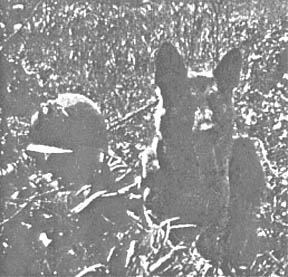 |
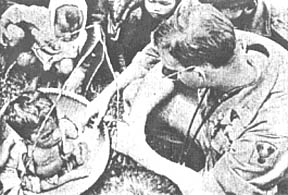 |
TOUGH JOB - Doctor (Capt.) Richard Rose, battalion surgeon, 3rd Bn., 21st Inf., examines one of a pair of 1-year-old girls born with a deficiency which prevents their bones from forming normally. |
Tropic Flashes
1ST BN, 27TH INF (Wolfhounds) - "Come home Connie." Sound
like the latest song on the hit parade? It's not. It's just the
cry of the 1/27th's Commo Plt. Connie, the platoon's mascot monkey
disappeared last week. The "Wolfhound" commo men are confident,
however, that she will return . . . Roy Burdette was promoted to MSgt E-8
recently at ceremonies held at HHC. 1st Sgt. Bobby Sturgen stepped into
the top NCO slot at Co. A recently. Congratulation Sgt. Sturgen .
2ND BN, 27TH INF (Wolfhounds) - WO Ronald L. Grone and SP4 Oliver L. Avant both
welcomed new members to their respective families recently. WO Grone is
busy picking a name for his new son while Specialist Avant has his hands full
choosing a name for his daughter . . . PSgt. Benjamin Hunter added a diamond to
the middle of all those stripes to become the 1st Sgt of Co. C.
1ST BN (MECH), 5TH INF (Bobcats) - The "Mech" said good-by
recently to Capt. Robert Rogers. Capt. Rogers rotated to his new
assignment at the Infantry School at Fort Benning, Ga. 1st Lt. John W. Leek left his job as platoon leader in Ca.
A recently to move into his new post with Cu Chi Special Services . . . Shortly
before he rotated, 1st Lt. Howard E. Mahler exchanged salutes with a sergeant
from the 2nd Bn., 27th Inf., and both men burst into laughter. The
sergeant was James A. Mahler, Lt. Mahler's brother. The two career men
got together to celebrate their promotions which occurred on the same day.
But that was not all. It also happened to be Sgt. Mahler's birthday.
2ND BN, 14TH (Golden Dragons) - The officers and men of the 2/14th
would like to welcome the following personnel to the unit: Sp4 Dennis Strimike,
James Clardy and Robert Haslett and PFC's Larry Yerg, James Miller, Dewie
Cowart, Feliberto Rodriguez, Anthony Vermander, Chester Kowalski, Daniel
Hemphill, Joseph Soros, Benjimin Morgan, Larry Smith, Donald Preston, George
Stephenson, Ellison Morgan, Robert Walker, Xavier Johnson, Jerry Howard,
Lawrence Barnes, Ronald Dugan, Steven Nott, Paul Hjelmervik, Paul Holk, Dennis
Jaros, Timothy Watchman, Ernest Du Pont, David Fisher, Richard Koenig, Ernest
Buie, Anthony Arcuri, Hamp Boyd, James Ruggierio, Richard Barnes, Ronald Self,
Travis Sullivan and Freddie Hawkins . . . - PFC Kenneth Hardy, a medic
with the first platoon of Co. C, was recently notified by the American Red Cross
that his wife gave birth to a girl.
12TH EVACUATION HOSPITAL (Be the Best) - Capt. James Parker, a
pathologist assigned to the 9th Medical Laboratory in Saigon, and Capt. Robert
Yario, a battalion surgeon with the 1st Inf. Div. recently joined the staff of
the 12th Evac . . . A wee bit of the Irish has crept into the 12th in the person
of Capt. Thomas McDonald. Capt. McDonald is a native of Dublin, Ireland.
He first joined the hospital in February of 1966 at Fort Ord, Calif.
Mech Drops in on Cong, Just in Time for Lunch
"Sorry about that." said Capt Little, "but I guess
Charlie just couldn't stay for lunch today."
Capt. William W. Little, commanding officer of Co. B, 4th Bn.
(Mech.), 23rd Inf., had just led his men into a VC base camp at high noon and
interrupted the enemy's lunch break.
Freshly cleaned chickens were strewn everywhere and pots were
heating up over untended fires as the men of the "Tomahawks"' roared into
the deserted camp. The camp was discovered while the unit was taking part
in Operation "Gadsden" in the dense jungles of War Zone C, about 20 miles
northwest of Tay Ninh.
One of the track commanders joked, "It looks as if Charles
isn't home."
He and his men dismounted to search a bunker and trench system.
The search parties turned up 1 carbine, 2 gas masks, 150 rounds of small arms
ammunition and assorted clothing, foodstuffs and documents. In addition, a
number of fortified bunkers, foxholes, and trenches were found and destroyed.
Later in the week, the infantrymen hurt Charlie in a bit of a
different way - they smashed his liquor still.
The set-up included a 100-gallon still, 200 gallons of bubbling
mash and 80 bottles of the hard liquor. One track commander swore he saw
tears in the eyes of his men as he smashed the bottles.
F Trp. Helps 'Forces' Unit
The 3,200-foot "Black Virgin" Mountain near Tay Ninh has long
been a Viet Cong stronghold. The slopes are honeycombed with caves and
tunnels.
One of the 196th Lt. Inf. Bde.'s units, Trp. F. 17th Cav., was
recently given the mission of supporting a Special Forces assault on the Viet
Cong's mountain positions. As the troop moved dawn a road near the base
of the mountain, heavy small arms and 57mm recoilless rifle fire raked the
patrol. The troop immediately returned fire with its 106mm recoilless
rifles and wiped out the VC ambush positions.
The Special Forces commander on the other side of the mountain then
called on Trp. F's recoilless rifles for fire support on VC cave positions.
The troop's commander, Capt. Clyde W. Roan, of Daytona Beach, Fla., and 1st
Lt. Ronald B. Mattioli of Charleston, S.C., platoon leader, led a small security
force five miles down an enemy-controlled road to assist the Special Forces
elements there.
The 106's spit deadly fire, destroying two VC bunkers. The
Viet Cong then unleashed a barrage of mortar and small arms fire on the
cavalrymen. During this time Capt. Roan and Lt. Mattioli constantly
exposed themselves to enemy fire to complete the mission and enable the Special
Forces detachment to continue its operation.
Page 8 TROPIC LIGHTNING NEWS February 27, 1967
How LRRP Scored Big in Op. 'Gadsden'
By Sp4 Doug Kearney
"The eyes and ears of the division." That's what Maj.
Gen. Fred C. Weyand calls the 25th Inf. Div. Long Range Reconnaissance
Patrol (LRRP), and that's what he called decorated the men of two patrols
recently for their part in Operation "Gadsden."
Two Silver Stars, a Distinguished Flying Cross, six Bronze Star
Medals with "V" device, and three Air Medals with "V' device were
presented to the men of the two teams by General Weyand.
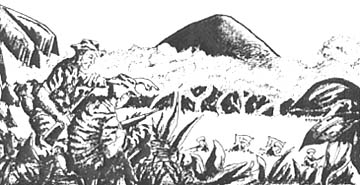 The general credited the two teams with pinpointing the position of
enemy forces. As a result, he was able to request an emergency B-52 raid
to destroy the Viet Cong.
The general credited the two teams with pinpointing the position of
enemy forces. As a result, he was able to request an emergency B-52 raid
to destroy the Viet Cong.
The first team went out on patrol from January 31 to February 2
under the leadership of Sgt. Jerry L. Caldwell, 29, of Kingsport, Tenn., a
member of Trp D, 3rd Sqdn., 4th Cav.
That evening four armed VC came straight toward the teams'
position. The team opened up with rifle fire and called in artillery to
within 50 yards of its own position. The team broke contact and moved
several hundred yards to set up for the night.
Toward dawn the next morning, the team spotted 12 VC within the
span of 90 minutes, but were able to stay hidden. The five men moved about
100 yards before they heard sounds and stopped. They called for artillery
fire and waited. After the firing stopped everything was quiet.
Suddenly, things began happening a little too quickly for comfort.
At 8 a.m., four VC were spotted near their position. A few minutes later,
six more came nearby and turned off into the woods. The five-man team
waited and watched. Then at 9 a.m. the sounds of voices came from all
around their position. It was time to go and they called for a helicopter
to extract them.
Half an hour later, nearly 20 VC began closing in on the team.
Them men pulled in and tried to remain hidden, but they were spotted by several
Viet Cong, a scant 10 feet away, and had to open fire. The pilot of the
pick-up chopper arrived before the gunships.
Sensing the urgency of the situation, aircraft commander Capt. Gary
I. Hatfield landed in the burning landing zone, and with cover from the door
gunners, the team escaped.
Sgt. Caldwell was awarded the Silver Star. Capt. Hatfield the
Distinguished Flying Cross.
Capt. Joseph A. Lacy, 28, of Columbus, Ga., commander of the LRRP
detachment, led the second patrol into enemy territory in the early morning of
February 3.
From late afternoon until early the next morning, about 150 Viet
Cong filed past their position. They moved in small groups, widely spaced,
and they all carried weapons ranging from pistols to light automatic weapons.
Capt. Lacy crawled to within ten yards of the moving enemy to observe and count
them.
Late in the afternoon of the same day an air raid bell sounded and
American planes soon were over the area, dropping bombs nearby. Soon
after, activity started again, and the patrol heard digging within 20 yards of
their night position, but they stayed where they were.
Early the next morning the patrol moved out toward a bridge they
had to cross, but spotted a VC ambush. Capt. Lacy moved close to the enemy
position and called in an air strike, killing four VC and capturing a rifle.
The patrol moved out and crossed the bridge. They had gone 200 yards when
they were spotted by two Viet Cong with rifles. After a brief fire fight,
one of the enemy lay dead and the other escaped. The patrol reached their
rendezvous point and was extracted without further incident.
Capt. Lacy was awarded the Silver Star for his action, and the
other four members of the team each received Bronze Star Medals with "V"
device. They were SSgt. Patrick L. Lacy, Cpt. Albert G. Pruden Jr., Sp4
Larry D. McIntosh and PFC William J. Boyd III.
2/27th Opens Filhol Freeway
The Cu Chi Turnpike Authority has officially announced the opening
of the Filhol Freeway, according to authority chairman Lt. Col. Robert Shelton.
Col. Shelton, commander of the 2nd Bn., 27th Inf., "Wolfhounds"
opened the expressway by waving through the first convoy to use the road.
The new ground link connects the division's Cu Chi base camp with
the hamlet of Phu Hoa Dong, some five miles to the north. It runs straight
through the middle of the Filhol Plantation, formerly a Viet Cong stronghold.
In opening remarks, the colonel noted that the road is "a symbol
of freedom for the people of Phu Hoa Doug - a hamlet that has been under VC
domination for 10 years or more." He said the Filhol Freeway is also a
symbol of American determination to stay and defeat the enemy.
At the conclusion of his remarks, the colonel asked that all
present bow their heads in a moment of silent meditation for the fallen comrades
whose sacrifices had, in part, made the opening of the road a reality.
As each vehicle rumbled by, the assistant driver took the guidon of
his unit into the cab for the journey. Units represented included the 2nd
Bn., 27th Inf., 65th Engr. Bn., and the 2nd Bn., 34th Armor, - all of whom Col.
Shelton praised for their part in opening the new road.
VC Commo Cache
Elements of the 25th located a store of communications equipment 25
miles northwest of Tay Ninh during Operation "Gadsden" recently. The
equipment included maps, radio tables, field telephones, a wire antenna, voltage
meters, a radio, hand-cranked generators and other communications accessories.
An unknown number of Chicom radio instruction booklets were also found.
1/27th Erects New
Theatre, Biggest Screen at Cu Chi
"Wolfhounds do things in a big way." said Maj. Arnold
Ponder Jr., as he pointed to his battalion's new movie theatre. "It's the biggest screen in the Cu Chi base camp."
Morale is a matter of constant concern to Maj. Ponder, the
executive officer of the 25th division's 1st Bn., 27th Inf. Building the
huge projection palace is just one of his ways of telling the Wolfhounds
they're doing a good job.
"Entertainment Palace" is hardly an exaggeration, because, as
the major pointed out, there are seats enough for the entire battalion, there
are two projectors to provide continuous entertainment without stopping for reel
changes and there is a stage in front of the cinemascope screen.
Prior to coming to Vietnam the Wolfhounds had the unique custom of
putting on shows starring the men themselves. Although it hasn't been
possible yet here in Vietnam, Maj. Ponder hopes to start it again soon. He said.
"I want to inaugurate our stage with a Special Services or USO show, - a short
one, just for the men of this battalion - to show our appreciation for the job
these men do."
An engineering marvel in itself, the 512-square-foot screen
measures 16 by 32 feet. The division's 125th Sig. Bn. cooperated by
digging deep holes and sinking three telephone poles to hold the screen.
The screen is made of 16 four-by-eight sheets of plywood painted white and
bolted to a specially built welded framework of steel engineer stakes.
The framework is in turn attached with heavy bolts to the three telephone poles.
Maj. Ponder said it took three light duty carpenters (They
weren't carpenters then, but they are now.) and four Vietnamese laborers ten
days to complete the entertainment palace. He says a roof will definitely
go up before the start of the rainy season.
| Nancy 'Walks' at Tay Ninh Mini-skirted, feline-like singer Nancy Sinatra enthralls the roving eyes of photographers and some 4,000 soldiers of the 196th Lt. Inf. Bde. as she swings through a medley of songs concerning "tom cats" and "boots" that walk all over you. Jimmy Boyd of "Bachelor Father" fame entertained the country and western music lovers with their favorite songs. A group calling themselves the Gordian Knots provided the music and sang a few songs of their own during the show. |
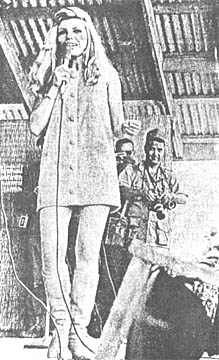 |
Thanks to
Ron Leonard, 25th Aviation Battalion for locating and mailing this issue,
Kirk Ramsey, 2nd Bn., 14th Inf. for creating this page.
This page last modified 8-12-2004
©2004 25th Infantry Division Association. All rights reserved.